Assessment of the Technical Condition of High-Voltage Insulators during Operation
Abstract
:1. Introduction
2. Materials and Methods
3. Results and Discussion
3.1. Measurement of Parameters of Very Large Partial Discharges
- -
- Occurrence of a VLPD near zero values of the applied high voltage Ua (that is, at phases 0°-180°-360°), Figure 5;
- -
- Increase in the number of VLPDs in negative Ua half-periods in relation to positive half-periods. If for the first two groups of samples this ratio N+/N− is close to unity, then for the third group N−/N+ ˃ 1, and it increases with increasing defectiveness;
- -
- An increase in the number of VLPDs and a simultaneous decrease in the total number of PDs with an increase in the size of defects (Figure 6);
- -
- An increase in the VLPD intensity with an increase in the size of defects (Figure 7).
3.2. Characteristics of Partial Discharges in High-Voltage Insulators
3.3. Generalized Physical Model of Very Large Partial Discharges
4. Conclusions
5. Patents
- Certificate of state registration of the computer program No. 2021668517 Russian Federation. Software package for recording and processing partial discharge signals in the process of monitoring the technical condition of high-voltage insulators: publ. 17 November 2021/D. A. Ivanov, A.V. Golenishchev-Kutuzov, A.V. Semenikov, T. G. Galieva; applicant Federal State Budgetary Educational Institution of Higher Education “Kazan State Energy University”;
- Utility model patent No. 206382 U1 Russian Federation, IPC H02J 13/00. Device for operational monitoring of the technical condition of high-voltage power transmission lines: No. 2021113356: application 11.05.2021: publ. 8 September 2021/M. F. Sadykov, M. P. Goryachev, D. A. Yaroslavsky [et al.]; applicant Federal State Budgetary Educational Institution of Higher Education “Kazan State Energy University”;
- Certificate of state registration of the computer program No. 2022662455 Russian Federation. A program for processing signals from acoustic sensors: publ. 17 November 2021/Ivanov D.A., Galieva T.G., Sadykov M.F., Yaroslavsky D.A., Goryachev M.P., Khamidullin I.N., Vagapov A.I.; applicant Federal State Budgetary Educational Institution of Higher Education “Kazan State Energy University”.
Author Contributions
Funding
Conflicts of Interest
References
- Niemeyer, L. A generalized approach to partial discharge modeling. IEEE Trans. Dielectr. Electr. Insul. 1995, 2, 510–528. [Google Scholar] [CrossRef] [Green Version]
- Vdoviko, V.P. Chastichnye Razryady v Diagnostirovanii Vysokovol’tnogo Oborudovaniya (Partial Discharge in the Diagnosis of High-Voltage Equipment); Science: Novosibirsk, Russia, 2007; p. 150. [Google Scholar]
- Pan, C.; Meng, Y.; Wu, K.; Han, Z.; Qin, K.; Cheng, Y. Simulation of partial discharge sequences using fluid equations. J. Phys. D Appl. Phys. 2011, 44, 255201. [Google Scholar] [CrossRef]
- Illias, H.A.; Chen, G.; Lewin, P.L. The influence of spherical cavity surface charge distribution on the sequence of partial discharge events. J. Phys. D Appl. Phys. 2011, 44, 245202. [Google Scholar] [CrossRef] [Green Version]
- Wu, K.; Pan, C.; Meng, Y.; Cheng, Y. Dynamic behavior of surface charge distribution during partial discharge sequences. IEEE Trans. Dielectr. Electr. Insul. 2013, 20, 612–619; [Google Scholar] [CrossRef]
- Kupershtokh, A.L.; Karpov, D.I. Simulation of waves of partial discharges in a chain of gas inclusions located in condensed dielectrics. J. Phys. Conf. Ser. 2016, 754, 102006. [Google Scholar] [CrossRef] [Green Version]
- Golenishchev-Kutuzov, A.V.; Golenishchev-Kutuzov, V.A.; Ivanov, D.A.; Khusnutdinov, R.A.; Mardanov, G.D.; Evdokimov, I.A. Complex method for remote control of the state of high-voltage insulators, Power Eng. Res. Equip. Technol. 2016, 5–6, 87–93. [Google Scholar]
- Golenishchev-Kutuzov, A.V.; Golenishchev-Kutuzov, V.A.; Ivanov, D.A.; Mardanov, G.D.; Semennikov, A.V. Remote testing for defects in in-service high-voltage insulators. Russ. J. Nondestruct. Test. 2018, 54, 682–686. [Google Scholar] [CrossRef]
- Callender, G.; Golosnoy, I.O.; Rapisarda, P.; Lewin, P.L. Critical analysis of partial discharge dynamics in air filled spherical voids. J. Phys. D: Appl. Phys. 2018, 51, 125601. [Google Scholar] [CrossRef] [Green Version]
- Illias, H.A.; Chen, G.; Lewin, P.L. Comparison between three-capacitance, analytical-based and finite element analysis partial discharge models in condition monitoring. IEEE Trans. Dielectr. Electr. Insul. 2017, 24, 99–109. [Google Scholar] [CrossRef]
- Pan, C.; Chen, G.; Tang, J.; Wu, K. Numerical modeling of partial discharges in a solid dielectric-bounded cavity: A review. IEEE Trans. Dielectr. Electr. Insul. 2019, 26, 981–1000. [Google Scholar] [CrossRef]
- Golenishchev-Kutuzov, A.V.; Golenishchev-Kutuzov, V.A.; Ivanov, D.A.; Mardanov, G.D.; Semennikov, A.V. Integrated Noncontact Diagnostics of the Operable Condition of High-Voltage Insulators. Russ. J. Nondestruct. Test. 2019, 55, 596–602. [Google Scholar] [CrossRef]
- Golenishchev-Kutuzov, A.V.; Golenishchev-Kutuzov, V.A.; Ivanov, D.A.; Mardanov, G.D.; Semennikov, A.V.; Ahmetvaleeva, L.V. Effect of partial discharges on the operating condition of high-voltage insulators. E3S Web Conf. 2019, 124, 03001. [Google Scholar] [CrossRef] [Green Version]
- Golenishchev-Kutuzov, A.V.; Ivanov, D.A.; Kalimullin, R.I.; Semennikov, A.V. Remotely Measured Diagnostic Parameters for Estimating the Residual Life of High Voltage Insulators. Bull. Russ. Acad. Sci. Phys. 2020, 84, 1502–1504. [Google Scholar] [CrossRef]
- Golenishchev-Kutuzov, A.V.; Golenishchev-Kutuzov, V.A.; Ivanov, D.A.; Semennikov, A.V.; Galieva, T.G. Monitoring System of High Voltage Dielectric Equipment. E3S Web Conf. 2021, 288, 01088. [Google Scholar] [CrossRef]
- Borghei, M.; Ghassemi, M.; Rodríguez-Serna, J.M.; Albarracín-Sánchez, R. A finite element analysis and an improved induced charge concept for partial discharge modeling. IEEE Trans. Power Deliv. 2021, 36, 2570–2581. [Google Scholar] [CrossRef]
- Piccin, R.; Mor, A.R.; Morshuis, P.; Montanari, G.C.; Girodet, A. Partial discharge analysis and monitoring in HVDC gas insulated substations. In Proceedings of the 2014 IEEE Electrical Insulation Conference (EIC), Philadelphia, PA, USA, 8–11 June 2014; pp. 488–492. [Google Scholar] [CrossRef]
- Florkowski, M. Influence of harmonics on partial discharge measurements and interpretation of phase-resolved patterns. Measurement 2022, 196, 111198. [Google Scholar] [CrossRef]
- Pan, C.; Wu, K.; Chen, G.; Florkowski, M.; Lv, Z.; Tang, J. Understanding Partial discharge behavior from the memory effect induced by residual charges: A Review. IEEE Trans. Dielectr. Electr. Insul. 2020, 27, 1936–1950. [Google Scholar] [CrossRef]
- Li, Z.; Luo, L.; Sheng, G.; Liu, Y.; Jiang, X. UHF partial discharge localisation method in substation based on dimension-reduced RSSI fingerprint. IET Gener. Transm. Distrib. 2018, 12, 398–405. [Google Scholar] [CrossRef]
- Ilkhechi, H.D.; Samimi, M.H. Applications of the acoustic method in partial discharge measurement: A review. IEEE Trans. Dielectr. Electr. Insul. 2021, 28, 42–51. [Google Scholar] [CrossRef]
- Hou, H.; Sheng, G.; Jiang, X. Robust Time Delay Estimation Method for Locating UHF Signals of Partial Discharge in Substation. IEEE Trans. Power Deliv. 2013, 28, 1960–1968. [Google Scholar] [CrossRef]
- Tao, F.; Li, J.; Wei, C.; Wu, Y.; Lu, Y.; Lin, Y. Analysis of Monitoring System of Partial Discharge Electromagnetic Interference in Ultra-high Voltage Substation Environment. IOP Conf. Ser. Earth Environ. Sci. 2020, 440, 032066. [Google Scholar] [CrossRef]
- Galieva, T.G.; Ivanov, D.A.; Sadykov, M.F.; Golenishchev-Kutuzov, A.V. Laboratory stand for the development of a method and system for continuous non-contact non-destructive monitoring of the technical condition of insulating equipment, Omsk. Nauchnyi Vestn. 2021, 5, 80–87. [Google Scholar] [CrossRef]
- Ivanov, D.A.; Sadykov, M.F.; Yaroslavsky, D.A.; Golenishchev-Kutuzov, A.V.; Galieva, T.G. Non-Contact Methods for High-Voltage Insulation Equipment Diagnosis during Operation. Energies 2021, 14, 5670. [Google Scholar] [CrossRef]
- Kinsht, N.V.; Petrunko, N.N. On the estimation of parameters of partial discharges. Electricity 2016, 6, 51–56. [Google Scholar]
- Usachev, A.E.; Kubarev, A.Y. Problems of insulation diagnostics of power equipment by the method of partial discharges. E3S Web Conf. 2021, 288, 01077. [Google Scholar] [CrossRef]
- IEC TS 62478:2016; High voltage test techniques—Measurement of partial discharges by electromagnetic and acoustic methods. International Electrotechnical Commission: Geneva, Switzerland, 2016.
- GOST R 55191; High voltage test methods. Measurements of partial discharges. Rosstandart: Moscow, Russia, 2012.
- National Instruments USB6341. Multifunctional Data Input/Output Device. Technical Description. [Electronic Resource]. Available online: https://www.ni.com/pdf/manuals/377879a (accessed on 13 September 2022).
- Ramirez-Nino, J.; Pascacio, A. Acoustic measuring of partial discharge in power transformers. Meas. Sci. Technol. 2009, 20, 115108. [Google Scholar] [CrossRef]
- Pustovoit, V.I. Interaction of electron streams with elastic lattice waves. Sov. Phys. Uspekhi 1969, 12, 105–132. [Google Scholar] [CrossRef]
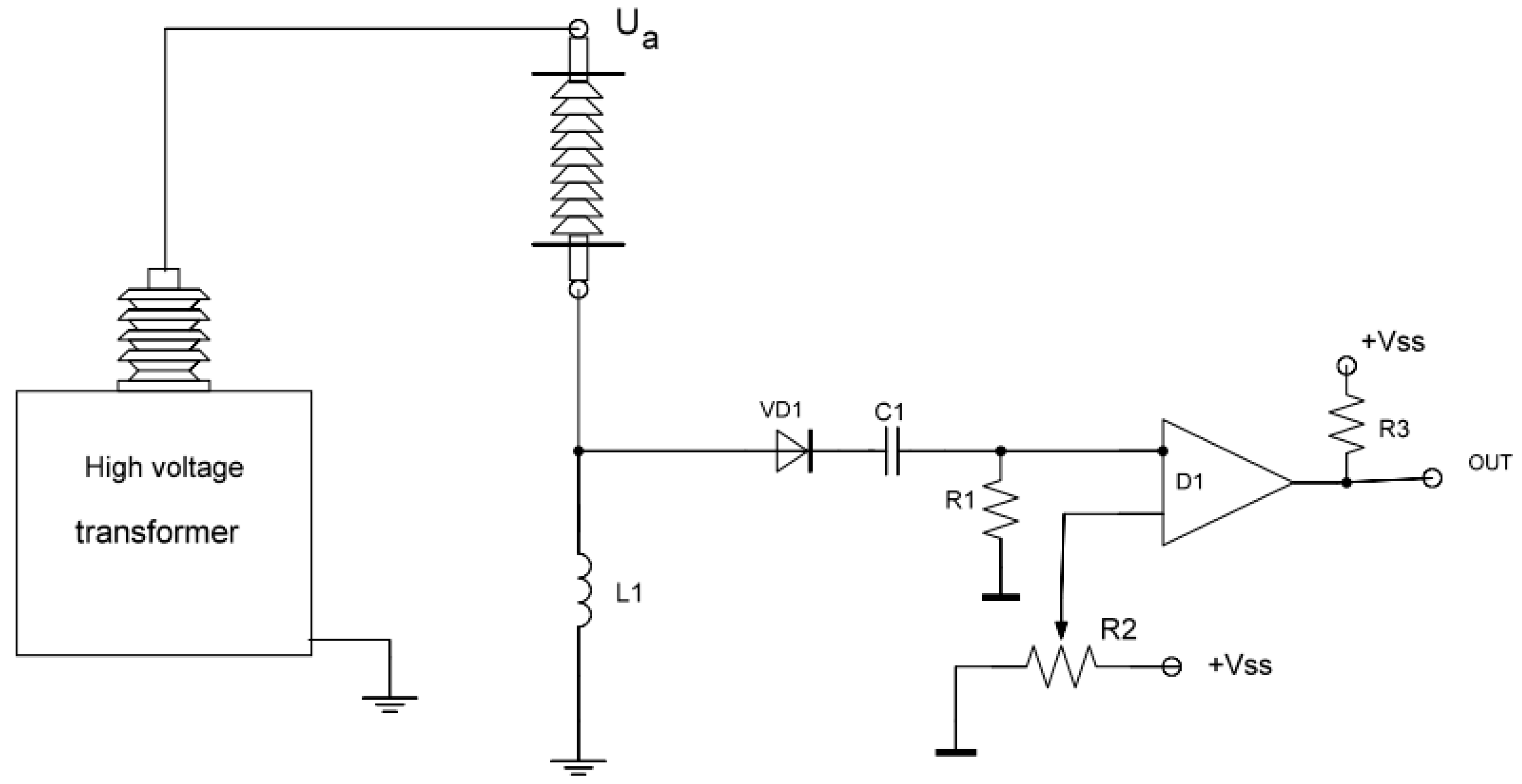
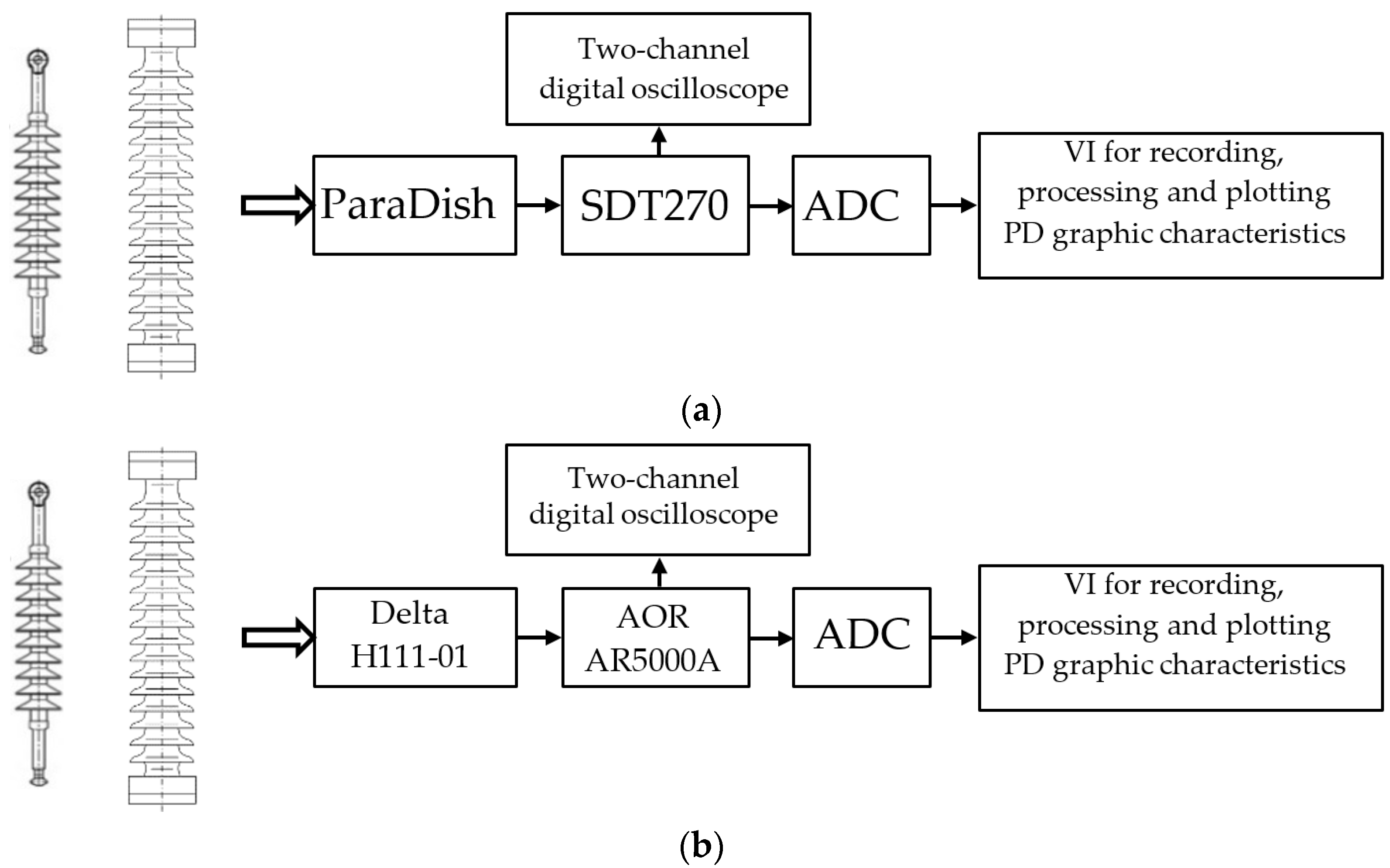
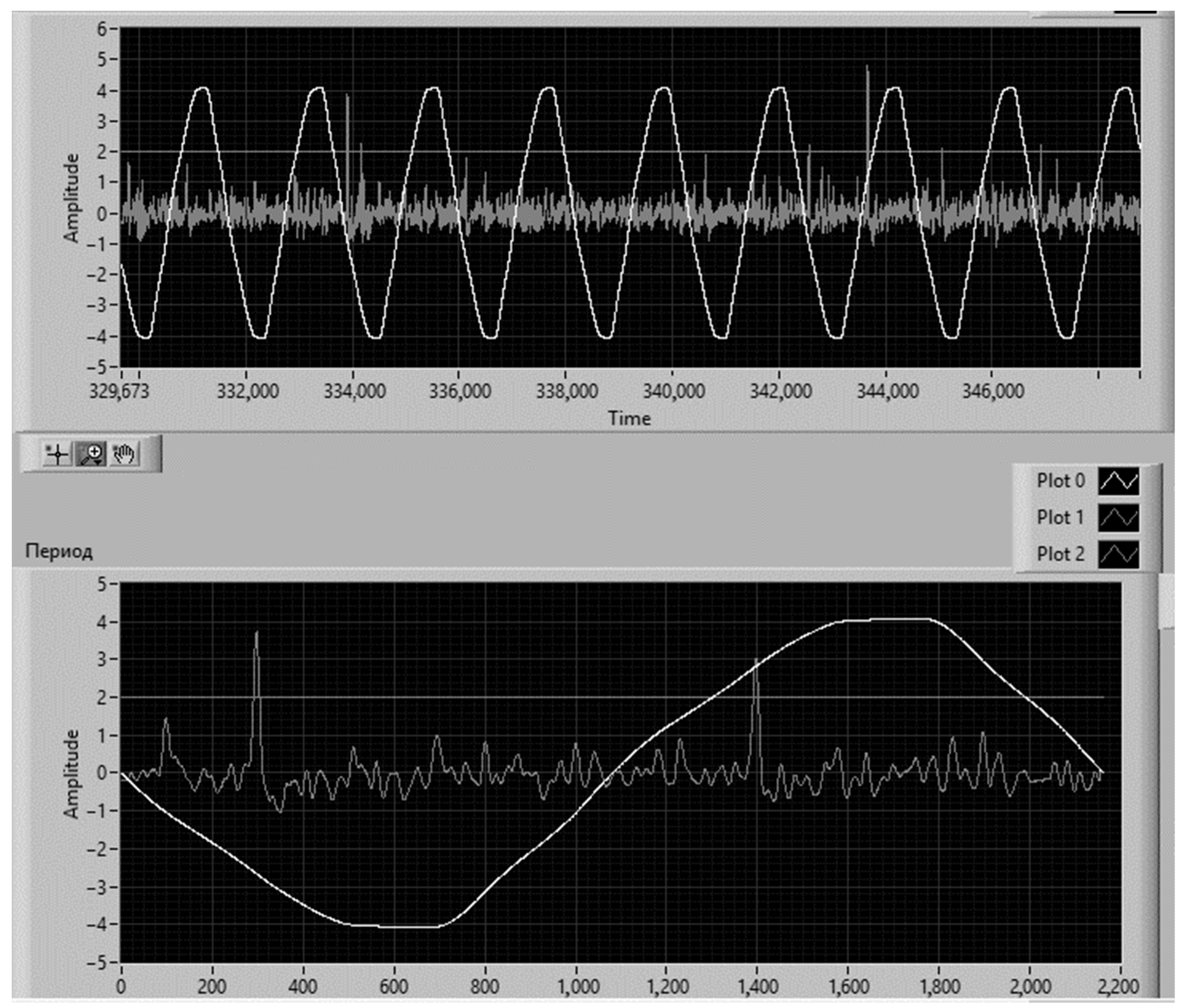

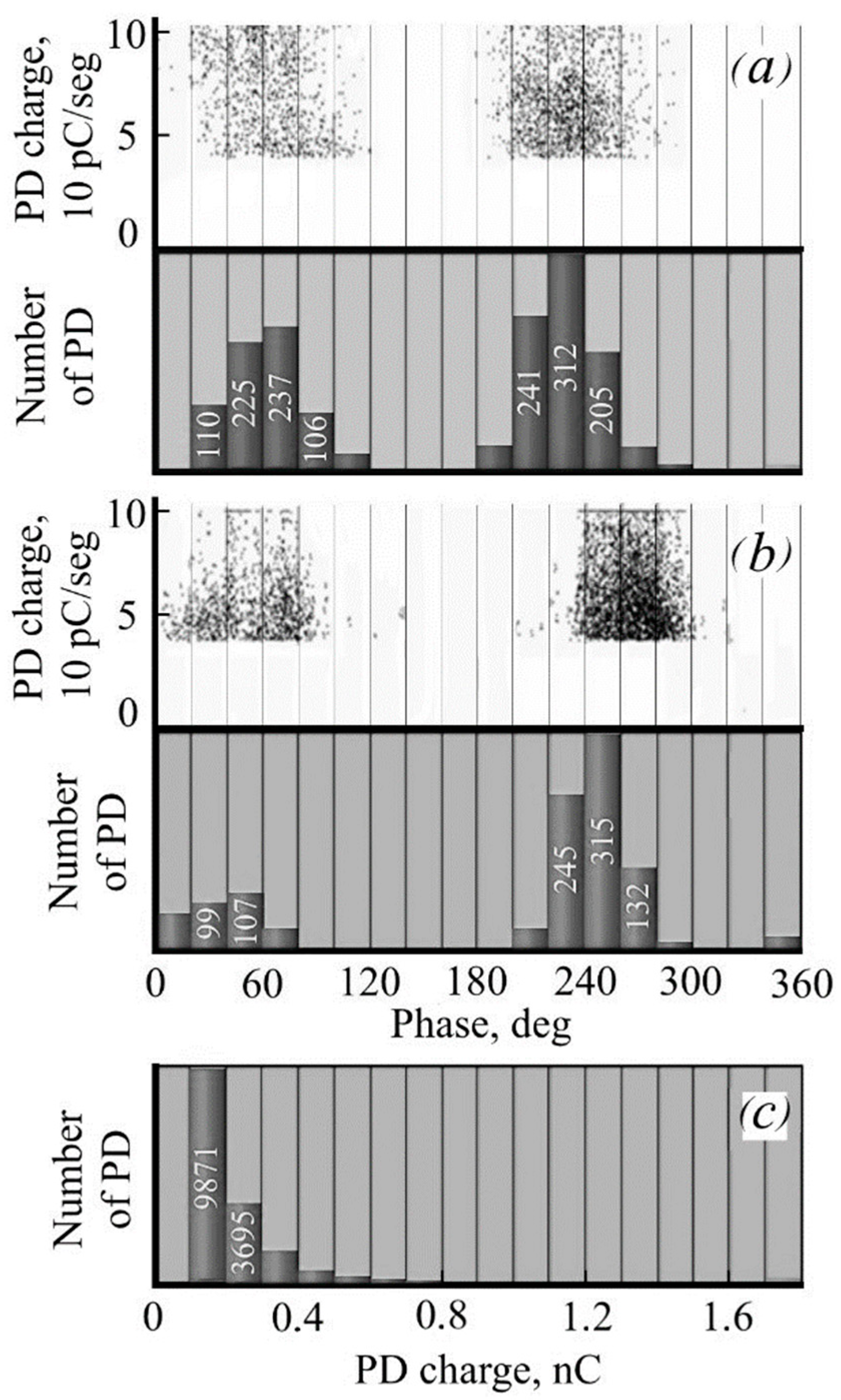
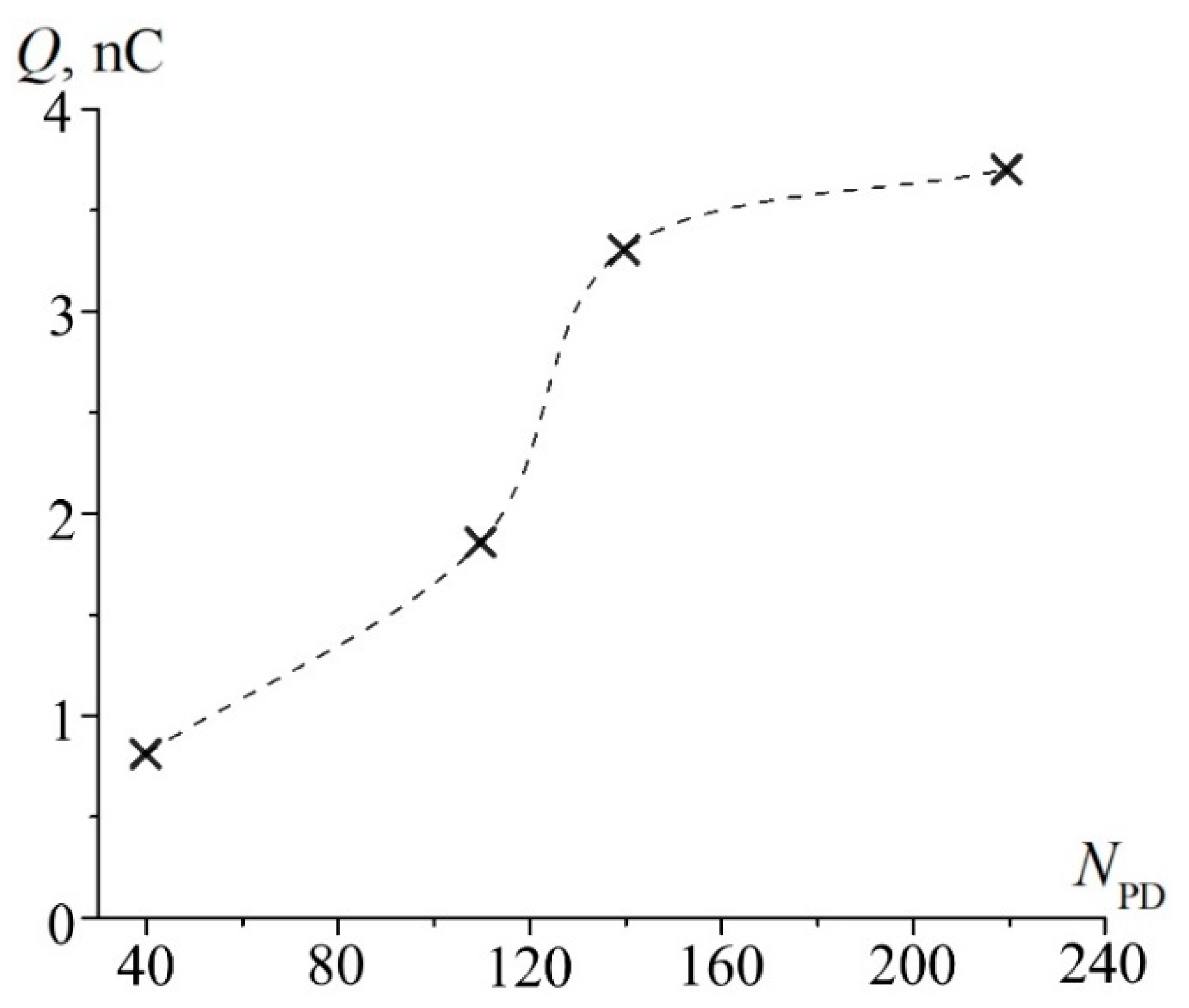
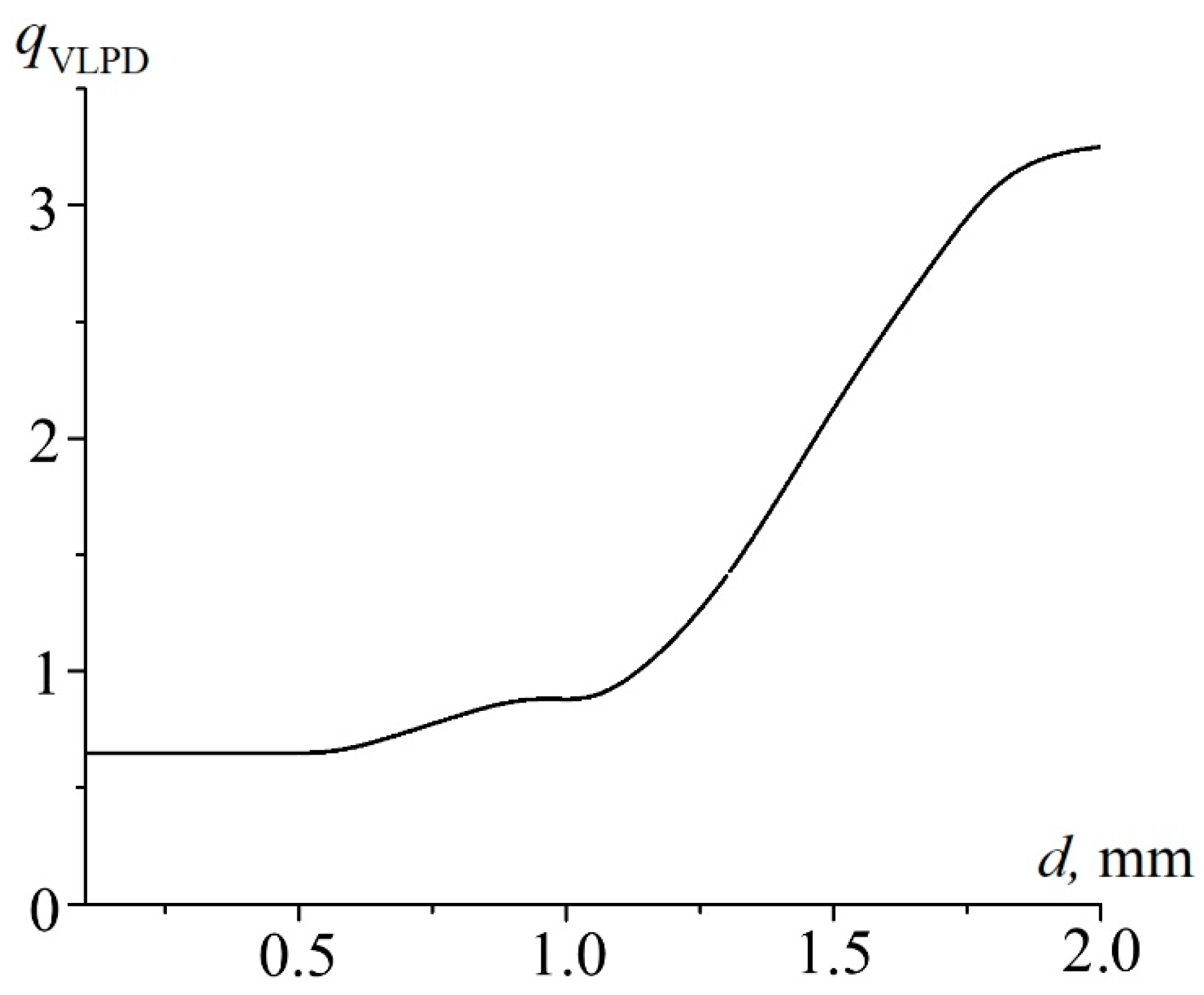
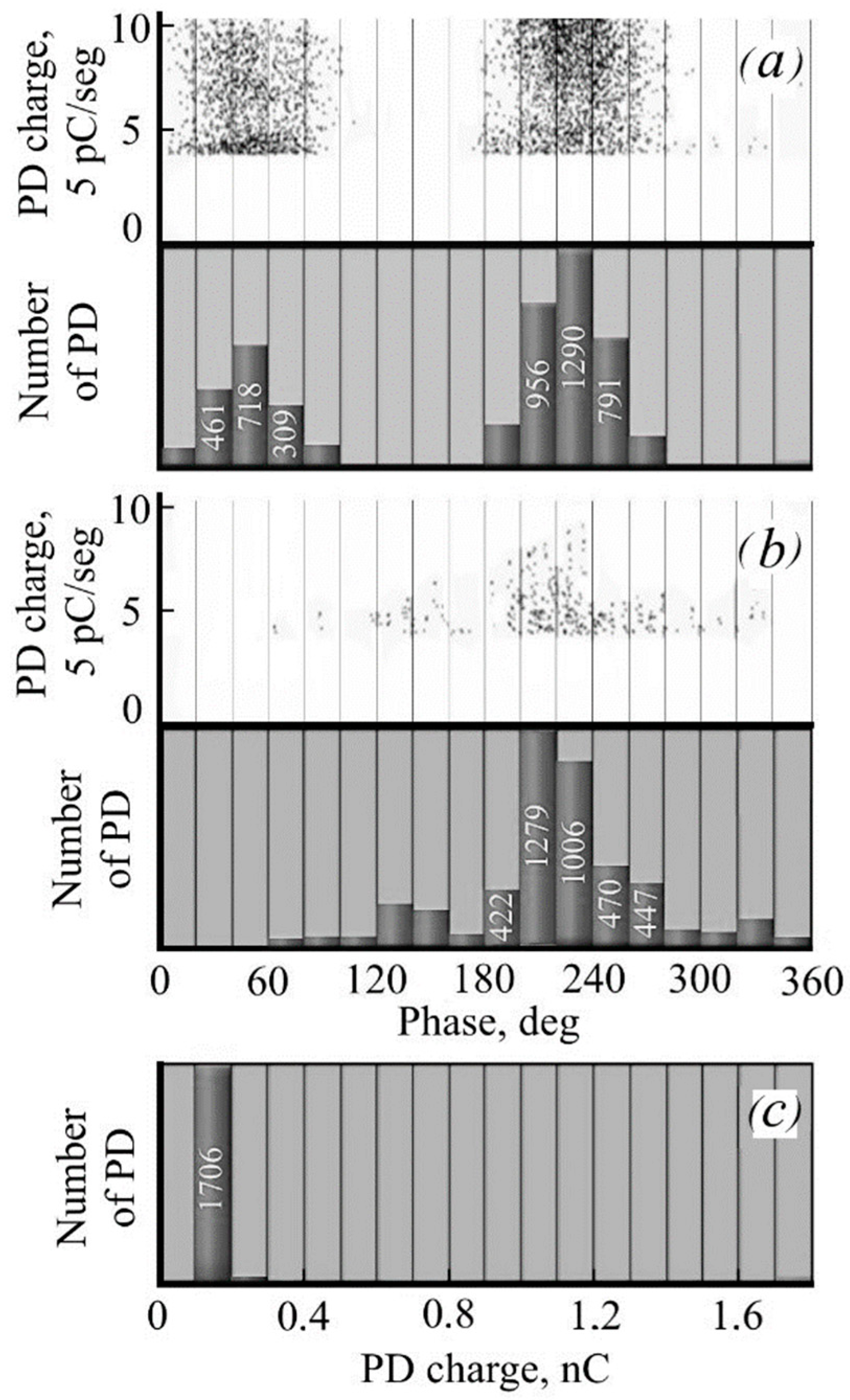
| Electromagnetic Channel | Acoustic Channel | |
|---|---|---|
| Frequency range | 0.5–800 MHz | 15.1–190.7 kHz |
| Bandwidth | 15 kHz–15 MHz | ±2 kHz at 6 dB |
| Sensitivity | 10 pC with a signal-to-noise ratio = 3 | 65 dB (1 V/1 mbar) |
| Parameter | Parameter Value | Resolution |
|---|---|---|
| Number of analog inputs | 16 | 16 bits, 500 kSample/sec |
| Number of analog outputs | 2 | 900 kSample/sec |
| Number of digital I/O ports | 24 | |
| Number of 32 bit timer counters for PWM generation | 4 | |
| Counting pulses | Yes |
| Group | (1) qmax ≤ 1.5 nC | (2) 1.5 ≤ qmax ≤ 2.5 nC | (3) qmax ≥ 2.5 nC | ||||
|---|---|---|---|---|---|---|---|
| Defect Type | Small | Medium | Large | ||||
| Sensors | Electro-magnetic | Acoustic | Electro-magnetic | Acoustic | Electro-magnetic | Acoustic | |
| q, pC | + | 10–20 | 10–20 | 20–50 | 50–200 | 200 | 1000 |
| − | 10–20 | 10–20 | 50–500 | 100–500 | 500 | 2000 | |
| N | + | 15–25 | 15–25 | 10–30 | 50–100 | 100–150 | 100–200 |
| − | 15–25 | 15–25 | 30–50 | 500–100 | 500 | 3000–5000 | |
| Δφ | + | 60–100 | 60–100 | 40–100 | 210–320 | 20–100 | 200–340 |
| − | 240–280 | 240–280 | 200–300 | 200–320 | 20–120 | 200–340 | |
| φstart | + | 60–40 | 60–40 | 40–30 | 40–30 | 30–20 | 30–20 |
| − | 240–220 | 240–220 | 220–210 | 220–210 | 200–190 | 200–100 | |
| Ntotal | 1.9 × 104–104 | 104–5 × 103 | 4 × 103–3 × 103 | 3 × 103–103 | |||
| Nmax | 30–150 | 50–250 | |||||
| Nmax/Ntotal | 0.8 × 10−2 | 3.36 × 10−2 | |||||
| No.3 | No.4 | No.5 | No.6 | |
|---|---|---|---|---|
| ΔNmax | 36 | 82 | 205 | 109 |
| Nmax | 4380 | 4300 | 4300 | 3000 |
| ΔN/Nmax | 0.8 × 10−2 | 1.9 × 10−2 | 3.6 × 10−2 | 4.0 × 10−2 |
| Ntotal | 1400 | 620 | 1400 | 200 |
| N− | 1300 | 940 | 2900 | 2300 |
| N+/N− | 1.05 | 0.65 | 0.48 | 0.09 |
Publisher’s Note: MDPI stays neutral with regard to jurisdictional claims in published maps and institutional affiliations. |
© 2022 by the authors. Licensee MDPI, Basel, Switzerland. This article is an open access article distributed under the terms and conditions of the Creative Commons Attribution (CC BY) license (https://creativecommons.org/licenses/by/4.0/).
Share and Cite
Ivanov, D.; Golenishchev-Kutuzov, A.; Sadykov, M.; Yaroslavsky, D.; Galieva, T. Assessment of the Technical Condition of High-Voltage Insulators during Operation. Machines 2022, 10, 1063. https://doi.org/10.3390/machines10111063
Ivanov D, Golenishchev-Kutuzov A, Sadykov M, Yaroslavsky D, Galieva T. Assessment of the Technical Condition of High-Voltage Insulators during Operation. Machines. 2022; 10(11):1063. https://doi.org/10.3390/machines10111063
Chicago/Turabian StyleIvanov, Dmitry, Aleksandr Golenishchev-Kutuzov, Marat Sadykov, Danil Yaroslavsky, and Tatyana Galieva. 2022. "Assessment of the Technical Condition of High-Voltage Insulators during Operation" Machines 10, no. 11: 1063. https://doi.org/10.3390/machines10111063
APA StyleIvanov, D., Golenishchev-Kutuzov, A., Sadykov, M., Yaroslavsky, D., & Galieva, T. (2022). Assessment of the Technical Condition of High-Voltage Insulators during Operation. Machines, 10(11), 1063. https://doi.org/10.3390/machines10111063







